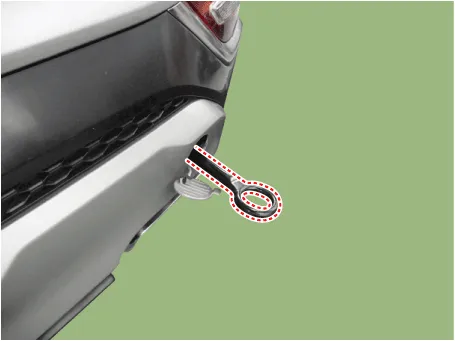Hyundai Palisade (LX2): Towing / General information
Hyundai Palisade (LX2) 2020-2025 Service Manual / General Information / Towing / General information
| Towing |
If the vehicle needs to be towed, call a professional towing service. Never
tow vehicle with just a rope or chain. It is very dangerous.
[Front]

[Rear]

Emergency Towing
There are three popular methods of towing a vehicle :
| – |
The operator loads the vehicle on the back of truck. This is best way
of transporting the vehicle.
|
| – |
The tow truck uses two pivoting arms that go under the tires of the
driving axle and lift them off the ground. The other two wheels remain
on the ground.
|
| – |
The tow truck uses metal cables with hooks on the ends. These hooks
go around parts of the frame or suspension, and the cables lift that
end of the vehicle off the ground. The vehicle's suspension and body
can be seriously damaged if this method of towing is attempted.
|
If the vehicle cannot be transported by flat-bed, should be towed with the wheels
of the driving axle off the ground and do the following :
Manual Transaxle
| • |
Release the parking brake.
|
| • |
Shift the Transaxle to neutral
|
Automatic Transaxle
| • |
Release the parking brake.
|
| • |
Start the engine.
|
| • |
Shift to [D] position, then [N] position.
|
| • |
Turn off the engine.
|
|
General information Basic Service Symbols There are five primary symbols used to complement illustrations. These symbols indicate the part to apply such materials during service.
Other information:
Hyundai Palisade (LX2) 2020-2025 Service Manual: Blower Motor
Repair procedures Inspection 1. Connect the battery voltage and check the blower motor rotation. 2. If the blower motor does not operate well, substitute with a known-good blower motor and check for proper operation.
Hyundai Palisade (LX2) 2020-2025 Service Manual: Intake Actuator
Description and operation Description The intake actuator is located at the blower unit. It regulates the intake door by a signal from the control unit. Pressing the intake selection switch will shift between recirculation and fresh air modes.
Categories
- Manuals Home
- Hyundai Palisade Owners Manual
- Hyundai Palisade Service Manual
- Electrochromatic Mirror (ECM) with homelink system
- Towing Service
- Engine Mechanical System
- New on site
- Most important about car
Copyright © 2025 www.hpalisadelx.com - 0.0149

